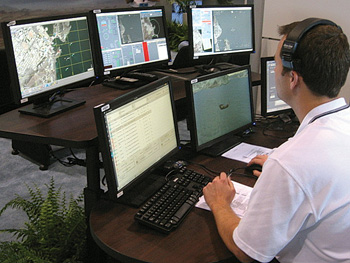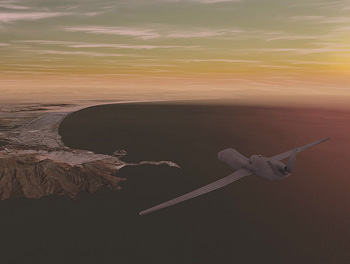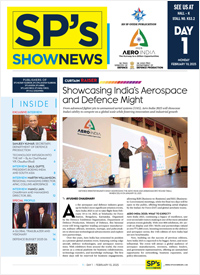- Prime Minister Narendra Modi inaugurates Aero India 2023 in Bengaluru; Releases Commemorative Stamp
- Defence Secretary meets delegations from Saudi Arabia, USA and Oman on the sidelines of Aero India 2023
- Foreign Ministers of 32 countries to attend Aero India 2023
- Embraer showcases the C-390 Millennium at Aero India 2023
CAE helping bridge the UAV training gap


CAE aims to transform unmanned aerial vehicle (UAV) training deficiencies and turn them to efficiencies with its unmanned aerial system (UAS) Mission Training Solution, specially designed to develop highly skilled crews who can operate in the highly complex mission environment.
A huge gap currently exists between desired UAV training and reality. Currently, UAV assets and personnel are often deployed quickly to the front line to meet the demands of the battlefield. The result is live “training” UAVs are generally unavailable, and airspace in which to hone skills is highly restricted. Just as importantly, crews are typically thrust into the real-world combat environment without first developing the mission crew teamwork afforded by dynamic simulation.
According to aerospace industry forecasts, a worldwide deployment of almost 30,000 UAVs-serving both military and civil markets-is expected by 2018, which will place an increasingly heavy burden on training these operators. India is expected to be one of the leading markets for UAVs.
Ananth Ramaswami, Managing Director of CAE India Pvt. Ltd, explained: “Military customers, including here in India, want a dynamic synthetic environment that enables them to link training systems together, just like they will fight on the battlefield. Plus, they want the ability to conduct mission rehearsals, train as a coordinated team, and reconfigure the synthetic training environment quickly so they can readily adapt to technology advances and constantly changing threats.”
“They need the entire mission training system to be cost-effective because militaries all over the world are facing significant budget constraints,” added Ramaswami.
CAE’s UAS Mission Training Solution addresses these needs. It supports multiple players, including the UAV pilot, sensor pilot, and mission commander/ instructor. The system can include a ground control station (for the pilots and sensor operator) and a mission management station where the instructor may create and monitor the environment and scenarios during training sessions.
CAE's open-architecture and common database allows operators to reconfigure vehicle and payload packages-a valuable feature in a world where crews are often trained mainly on platform-specific simulators. Operators also may switch between real and synthetic environments, as CAE’s UAS mission training solution is designed to be STANAG 4586-compliant (NATO Standardisation Agreement 4586). Also, there is no limit to the number of scenarios operators may build to match changing mission requirements, and the system offers a broad high-fidelity sensor suite that includes imaging (FLIR), radar (synthetic aperture radar), and electronic warfare.
To develop its solution, CAE teamed with consultancy unmanned experts to create a simulation and training solution that is aligned with real-world operations. Unmanned experts team of subject matter experts are seasoned fighter pilots, UAV pilots and sensor operators, and instructors who have gained realworld operational experience and “know what it takes to build success on the battlefield,” says Unmanned Experts Director of Operations Keven Gambold.
Gambold, a former Royal Air Force Tornado fighter pilot and Predator/ Reaper UAV pilot, offers more than 20 years of military experience. “An effective UAV operator, through realistic simulation scenarios, hones the observational and decision-making skills necessary to make correct decisions in combat,” note Gambold.
In contrast, a poorly prepared crew could make costly, if not fatal mistakes on the battlefield.
“When you practice, prepare, and rehearse in a synthetic environment, it becomes second nature to act and make informed, intelligent decisions when in combat,” added Gambold.
While the cost of a UAS Mission Training Solution can vary, depending on customer requirements, Ramaswami is quick to highlight the compelling advantages of simulation.
“A budget-conscious military wants to cut costs where possible and save equipment for operational use, but never at the expense of training its personnel for mission readiness and success,” says Ramaswami. “And that’s where high-fidelity simulation excels. You can provide realistic mission training in a simulation-based synthetic environment at a fraction of the cost.”
CAE anticipates the UAV simulation and training market will have a bright future with militaries around the world, as well as in the civil sector as national aviation authorities adopt regulations permitting the use of UAVs for civilian applications. Countries are utilising or exploring UAV applications in areas such as border patrol, surveillance of hydroelectric lines, and emergency management. The International Civil Aviation Organisation is setting guidelines for UAV licensing, and civil aviation authorities such as the Federal Aviation Administration (FAA) are exploring pilot and operational requirements for flying UAVs in civil airspace.
CAE's large global footprint and experience in training commercial pilots in the highly regulated commercial aviation market, helps make the company well-positioned to meet manned and unmanned vehicle training demands.
“We invest about 10 per cent of our bottom line annually into research and development specific to simulation and training,” notes Ramaswami. “At CAE, it's never 'one size fits all’. The company makes certain it can provide cost-effective solutions that offer leading-edge simulation technology. We think we have done that with our UAS Mission Training Solution.”
CAE will be demonstrating a range of simulation-based solutions at Defexpo 2012, including its UAS Mission Training Solution. CAE is located in Hall 10, Booth #2.





